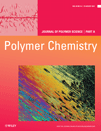Synthesis and fluorescent properties of model compounds for conjugated polymer containing maleimide units at the main chain
Abstract
2,3-Diaryl substituted maleimides as model compounds of conjugated maleimide polymers [poly(RMI-alt-Ar) and poly(RMI-co-Ar)] were synthesized from 2,3-dibromo-N-substituted maleimide (DBrRMI) [R= cyclohexyl (DBrCHMI) and n-hexyl (DBrHMI)] and aryl boronic acid using palladium catalysts. To clarify structures of conjugated polymer containing maleimide units at the main chain, 13C NMR spectra of 2-aryl or 2,3-diaryl substituted maleimides were compared with those of N-substituted maleimide polymers. Copolymers obtained with DBrRMI via Suzuki-Miyaura cross-coupling polymerizations or Yamamoto coupling polymerizations were dehalogenated structures at the terminal end. This dehalogenation may contribute to the low polymerizability of DBrRMIs. On the other hand, the π-conjugated compounds showed high solubility in common organic solvents. The N-substituents of maleimide cannot significantly affect the photoluminescence spectra of 2,3-diaryl substituted maleimides derivatives. The fluorescence spectra of poly(RMI-alt-Ar) and poly(RMI-co-Ar) varied with N-substituents of the maleimide ring. When exposed to ultraviolet light of wavelength 352 nm, a series of 1,4-phenylene- and/or 2,5-thienylene-based copolymers containing N-substituted maleimide derivatives fluoresced in a yellow to blue color. It was found that photoluminescence emissions and electronic state of π-conjugated maleimide derivatives were controlled by aryl- and N-substituents, and maleimide sequences of copolymers. © 2011 Wiley Periodicals, Inc. J Polym Sci Part A: Polym Chem, 2011




